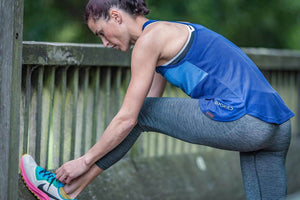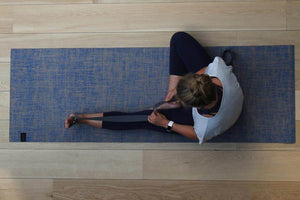We are forever being told we need to get fit and the question on everyone's lips is 'how do I get fit?' We look at what it means to get fit and all the ways we can get there. Your go-to guide for all tips to get fit.
What's Covered in this post
- How long until I get fit?
- How long does it take to get unfit?
- Could you be fit and fat?
- What is fit?
- Testing VO2 Max
- Cardio respiratory fitness
- Muscular strength
- Muscular endurance
- Body Composition
- Flexibility
How long until I Get Fit?
This question is one that most people will ask at one time or another, especially if they are keen to lose weight, tone up, and are working hard to achieve this. We all want to know when we’re going to see results, but unfortunately there is no clean cut figure which we can place on our fitness. We can, however, predict general patterns, though it is important to consider that everyone’s starting level of fitness differs and therefore so will the duration of time it takes to get fit.
Asking how long it will take to get fit" is a difficult question to answer as it is not quantitative; there is no template to say what is and isn't 'fit'. Results can be seen as little as a few days, but typically it takes a few weeks for your body to adapt to new stimuli, whether that’s diet, training, or both. This is why if you don’t see results in the first week, you shouldn’t feel disheartened.
Typically, the most measurable results follow after a minimum of 6-8 weeks. There is a common saying that it takes 4 weeks for you to see your body changing, 8 weeks for friends and family, and 12 weeks for the rest of the world.
The best way to determine how long it will take you to get fit is by setting fitness goals. You can also undertake fitness testing by doing physical fitness tests like a VO2 max test. There are other ways to test your fitness such as the sit and reach test or Astrand treadmill test.

Testing VO2 Max
Your VO2 max is an indication of how much oxygen your body can uptake during exercise. You can do several gym-based tests to determine your VO2 max. Alternatively, smart watches such as the Garmin Forerunner 235 running watch can calculate your VO2 max based upon your performance whilst wearing the watch. If running is not your thing, the Wattbike also calculates your VO2 max based on your performance during cycling.
Time trial Ideas
Time trial inspired fitness rulers are great for those who lack the technology to test VO2 max, as they are accessible to all. One example could be completing as many reps as possible of an exercise, for example burpees, in 2 minutes, or running a particular distance and measuring the improvement in time. Remember those awful beep tests at school? That’s just another fitness test and let’s face it you probably pushed that bit harder not because your PE teacher was shouting at you, but because there was an opportunity to beat your mates at something.

How long does it take to get unfit?
According to Dr. Edward Coyle, director of the Human Performance Lab at the University of Texas, in highly-trained athletes, VO2 max decreases by 7 percent in the 12 to 21 days after stopping training and another 9 percent during days 21 to 84.
So after just 3 weeks of inactivity, your fitness could decrease by up to 20%.
VO2 max is a measure of the maximum volume of oxygen that an athlete can use. It is measured in millilitres per kilogramme of body weight per minute (ml/kg/min).
Can you be fit and fat?
Being thin on the outside doesn’t necessarily mean you are fit or healthy on the inside. Whilst getting fit should be about maintaining the ideal weight for your height, it’s possible to have a healthy BMI and be unfit. You have to work at your fitness, it really is a 'use it or lose it' scenario.
“Can you be fit and fat?” was a question posed by Professor Steven Blair of the University of South Carolina. For eight years, Blair and his team studied the health of nearly 20,000 men between the ages of 30 and 83. He put them through complete physical assessments including treadmill tests for cardiovascular fitness and body composition assessments. The results concluded that fitness turned out to be a far more reliable predictor of health and longevity than either weight or BMI.
Unfit men with BMIs of less than 27 had a death rate that was 2.8 times greater than men with BMIs of 30 or higher (considered obese) who were moderately fit.
Blair also published a study on the role that fitness vs. fatness, or higher BMI, plays in women’s long-term health. Among 9,925 women who had been patients at the Cooper Clinic at the Cooper Institute, moderately fit women of all weights averaged a 48 percent lower risk of dying prematurely (from all causes) than unfit women. Highly fit women (those who could walk longest on the treadmill) had the lowest risk of premature death of all, nearly 60 percent lower than thin but unfit women.

What is Fit?
According to the United States Department of Health and Human Services, physical fitness is defined as "a set of attributes that people have or achieve that relates to the ability to perform physical activity."
There are 5 recognised main components for fitness:
Cardio-respiratory fitness
Cardio-respiratory fitness refers to how well our bodies can supply fuel during physical activity via our circulatory and respiratory systems. Any activity which increases your heart rate for an extended duration of time will help to improve your cardio-respiratory fitness. Exercising increases cardio-respiratory endurance in a number of ways: the heart muscle is strengthened so that it is able to pump more blood per heartbeat whilst at the same time additional small arteries are grown within muscle tissue so that blood can be delivered to working muscles more effectively when it’s needed. Cardio-respiratory fitness has been found to help ward off the risk of heart disease, lung cancer, type 2 diabetes and stroke, among other diseases.
Muscular strength
The US Department of Health and Human Services defines muscular strength as "the ability of muscle to exert force during an activity."
Generally, muscular strength is measured via comparing a person's ability to lift or push a given weight against the ability of the general population to do the same. If a muscle is worked consistently, it should increase in strength.
Related: How To Get Stronger
Muscular endurance
Muscular endurance is similar to muscular strength, but requires the ability to repeatedly execute strength. What do we mean by this? Whereas with muscular strength luck or adrenaline may push you through a single lift, here it’s how long you can keep going before your muscle tires.
Muscular strength training induces hypertrophy (muscle building), whereas muscular endurance requires a different energy system, which can last for longer.
Body composition
Body composition refers to the levels of muscle, bone, water and fat that make up your body. Two individuals who weigh the same could have completely different body compositions, which is why there is so much debate whether BMI is accurate as it only considers weight against height.
People with a high muscle mass will weigh more than those who are the same height with the same waist circumference because muscle weighs more than fat. The most accurate way of measuring body composition is through water submersion, and measuring volume and disposition. This is a long, tedious process and for most of us is inaccessible.
There are some smart scales and body composition monitors available on the general fitness market and whilst the accuracy of scales such as these often comes under scrutiny, it still gives the user a good idea of their body composition.
Flexibility
Flexibility is defined as the range of motion of your joints or the ability of your joints to move freely. It also refers to the mobility of your muscles, which allows for more movement around the joints. Flexibility can be increased by a variety of activities designed to stretch joints, ligaments and tendons such as stretching, foam rolling, and yoga.
There are three types of exercise that are generally utilised to increase flexibility:
- Dynamic stretching: the ability to complete a full range of motion of a particular joint. This type of flexibility is used in standard "warming up" exercises as it helps ready the body for physical activity
- Static-active stretching: holding the body or part of the body in a stretched position and maintaining that position for a period of time. One example of static-active stretching is doing the splits
- Ballistic stretching: only to be used when the body is already warmed up and limber from exercise, it involves stretching in various positions and then bouncing while holding the stretch. Some governing health bodies, including the American Academy of Orthopaedic Surgeons, believe that ballistic stretching can cause injuries.
A combination of these 5 elements will make a good overall level of fitness, although some may excel at some principles and not others. Fitness is largely subjective and it is important to balance good fitness and health.
To “get fit”, focus on any of the areas above which are weaker for you personally and work to improve them while also setting goals so that you know if you are making progress.








